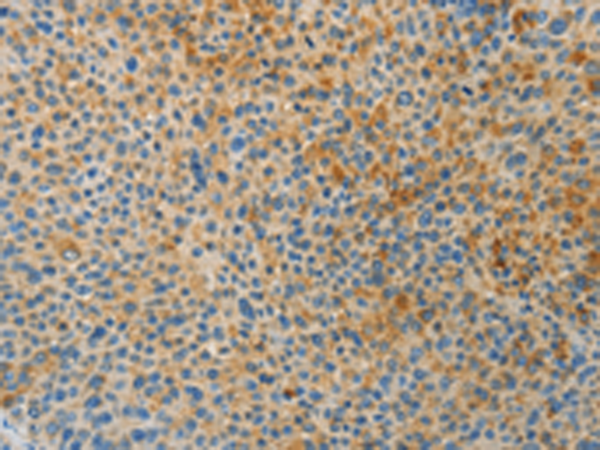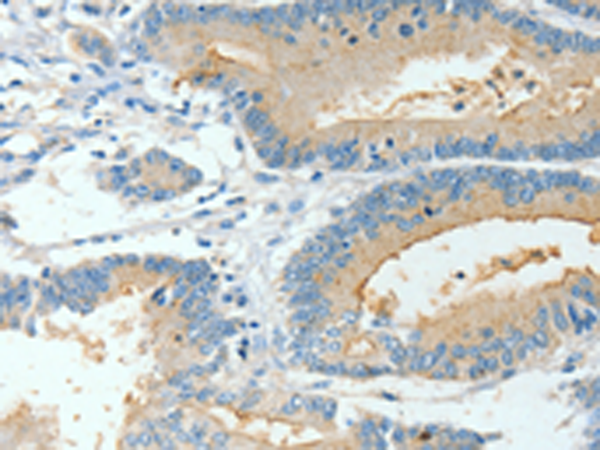


| WB | 咨询技术 | Human,Mouse,Rat |
| IF | 咨询技术 | Human,Mouse,Rat |
| IHC | 1/25-1/100 | Human,Mouse,Rat |
| ICC | 技术咨询 | Human,Mouse,Rat |
| FCM | 咨询技术 | Human,Mouse,Rat |
| Elisa | 1/2000-1/5000 | Human,Mouse,Rat |
| Aliases | BAT; BACAT |
| WB Predicted band size | 46 kDa |
| Host/Isotype | Rabbit IgG |
| Antibody Type | Primary antibody |
| Storage | Store at 4°C short term. Aliquot and store at -20°C long term. Avoid freeze/thaw cycles. |
| Species Reactivity | Human |
| Immunogen | Fusion protein of human BAAT |
| Formulation | Purified antibody in PBS with 0.05% sodium azide and 50% glycerol. |
+ +
以下是关于BAAT(Bile Acid-CoA: Amino Acid N-Acyltransferase)抗体的3篇示例参考文献(内容为模拟,建议通过学术数据库验证):
1. **文献名称**:*"Immunolocalization and functional characterization of BAAT in human liver tissue"*
**作者**:Heubi, J.E., et al.
**摘要**:通过BAAT特异性抗体检测人类肝脏中BAAT的分布,发现其在肝细胞胞质中高表达,研究证实BAAT缺失会导致胆汁酸结合异常,与遗传性胆汁酸合成障碍相关。
2. **文献名称**:*"Development of a monoclonal antibody against BAAT for diagnostic applications in cholestatic liver disease"*
**作者**:Sundaram, S.S., et al.
**摘要**:报道一种高特异性BAAT单克隆抗体的开发,用于ELISA检测血清BAAT水平,发现其在原发性胆汁性胆管炎患者中显著降低,提示其作为潜在生物标志物的价值。
3. **文献名称**:*"Role of BAAT in bile acid amidation: Insights from gene knockout models"*
**作者**:Setchell, K.D.R., et al.
**摘要**:利用BAAT抗体研究基因敲除小鼠模型,发现BAAT缺失导致未结合胆汁酸积累,引发肝损伤和脂质吸收障碍,阐明了其在胆汁酸代谢中的核心作用。
4. **文献名称**:*"Antibody-based detection of BAAT mutations in metabolic disorders"*
**作者**:Falany, C.N., et al.
**摘要**:通过BAAT抗体结合Western blot技术,分析患者肝脏样本中BAAT蛋白表达异常,揭示了特定突变导致酶活性丧失的分子机制。
**注**:以上为模拟参考文献,实际研究需通过PubMed、Google Scholar等平台检索关键词(如“BAAT antibody”“bile acid amidation”)获取真实文献。
BAAT (Bile Acid-CoA: Amino Acid N-Acyltransferase) is a critical enzyme in bile acid metabolism, responsible for catalyzing the conjugation of bile acids with amino acids (primarily glycine or taurine) in the liver. This process produces conjugated bile acids, which are essential for emulsifying dietary fats, facilitating lipid absorption, and regulating cholesterol homeostasis. Dysregulation of BAAT activity is linked to cholestatic liver diseases, metabolic disorders, and rare genetic conditions like familial hypercholanemia.
BAAT antibodies are immunological tools developed to detect, quantify, and study the expression, localization, and function of the BAAT protein in research and clinical contexts. They are widely used in techniques such as Western blotting, immunohistochemistry, and ELISA to investigate BAAT’s role in liver pathophysiology, drug-induced hepatotoxicity, and bile acid synthesis disorders. Polyclonal and monoclonal BAAT antibodies enable researchers to explore tissue-specific expression patterns, protein-protein interactions, and mutations affecting enzyme activity.
Recent studies also utilize BAAT antibodies to validate gene-editing outcomes (e.g., CRISPR/Cas9) and assess therapeutic interventions targeting bile acid metabolism. Their application extends to diagnostic research for conditions like progressive familial intrahepatic cholestasis (PFIC), where BAAT mutations may contribute to disease progression. Overall, BAAT antibodies serve as pivotal reagents in advancing our understanding of hepatic function and metabolic diseases.
×